Paul Diefenderfer: Forging a Rich Desert Life
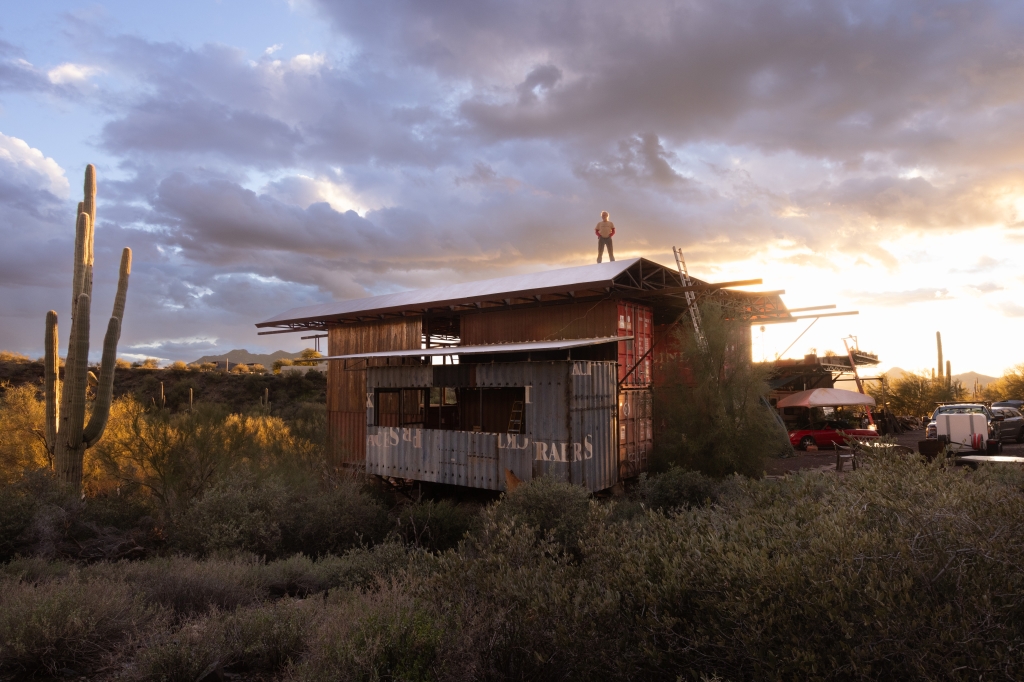
Writer Shannon Severson // Photography by Loralei Lazurek
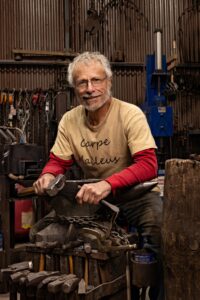


Paul Diefenderfer’s studio and personal project laboratory sits in a small valley off one of Cave Creek’s scenic backroads. Here he pursues his art, chips away at the huge task of constructing his sustainable dream home from retired shipping containers and serves the community with his knowledge and talents — and those abilities are numerous and sundry.
“Dief,” as he is more commonly called, started life as an Air Force kid, moving around the country and eventually becoming a computer programmer. He settled in Arizona in 1973 and made Cave Creek his home in 1992.
After living so long in an arid clime, he has become a true “desert rat,” as that is the name of this blacksmith’s personal forge. He has beaten kidney cancer and is monitoring his prostate cancer. He operates both a technical rigging business and one of the first indoor rock climbing gyms in the country — Phoenix Rock Gym, which he founded.
At Desert Rat Forge, Dief designs and builds bespoke metal projects that are both useful and artistic. He is a volunteer with Arizona Foothills 911 and is experienced in search and mountain rescue, both for humans and wildlife — and that’s just scratching the surface.
During our interview, a javelina wanders through, exploring the under-construction home on the property. Dief isn’t fazed one bit, though he does have stories about these local creatures making a mess of his work a time or two; once even getting into a store of wine bottles and ending up inebriated beneath one of the containers. He accepts it as part of living alongside nature, sharing the space and adapting to the wildlife and plants around him.
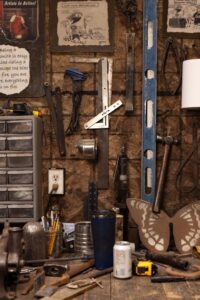


Forging a Life
It might seem that a man most accustomed to programming computers from a desktop wouldn’t find his purpose in almost all things outdoors-focused, but Dief has always enjoyed adventure.
“I like the adrenaline,” he reveals. “I like doing stuff [like white-water rafting, mountain biking and navigating the waterways of the Grand Canyon in a 14-foot boat]. I have the ability to learn [by watching others] and then I go out and try it.”
His work as a blacksmith began 25 years ago as a hobby.
“I was at a Magic Bird Arts Fair,” Dief recalls. “I was drawn to a blacksmith who was actually making stuff [at his booth]. If he had just been selling it, I would have probably walked right by; but he pulled the metal out of the forge and started hammering. I asked if he’d train me and I would work for free. He couldn’t do that because he lived in Camp Verde, but he recommended a club I could join and I’ve been doing [metalwork] ever since.”
Inside his studio, Dief has tools old and new — some antiques that he is refurbishing. At the outset of what became Desert Rat Forge, candleholders, hooks and simple artwork were first in his repertoire — and he still creates a series of those items for the Sonoran Arts League’s Hidden in the Hills Artist Studio Tour each fall.
His bread and butter, however, which is also his preferred work, are one-of-a-kind commissioned pieces, artistic and utilitarian. His work can be seen around Cave Creek, including the eight-foot spirit circle sculptures at Desert Foothills Library and Stagecoach Village.
“I don’t do production pieces,” Dief says. “I don’t want to do the same thing over and over. If you came and said, ‘I need 100 of something,’ I’d say to go find someone else. I do unique pieces of art.”
Customers rarely come to him with set plans; rather, they present an idea or vision and Dief makes it happen. He’s made metal gates, custom fixtures and fences. His biggest project was a 4-foot-wide, 100-foot-long pedestrian bridge for a private residence — a massive undertaking. In addition to passing muster with local codes and regulations, the bridge stood up under even more pressure when a fire truck accidentally rolled onto it. The truck’s grille was damaged, but the bridge was none the worse for wear.
“The client wanted something lightweight that looked like it was floating,” Dief recalls. “It was held up by a single post every 10 feet, built without machinery. I did it by hand and bucket from post to post. It hovers 8 feet above the wash. When I was finished, it looked like no one had touched the [ground beneath]. There was minimal disturbance.”
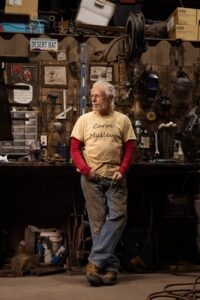


In the Details
An eye for detail, a desire for growth and a passion for creation flow through everything Dief does. Here on his land, he designed and is constructing a home and garage next to his studio. He notes that most guests end up in the living room and kitchen of a house when they visit, so half of this open-concept home is a central living room with a platform for live music performances from dear friends. A Pilates studio and garden room overlook the great room. There are also standard sleeping areas and a kitchen space.
“I’m not a structural engineer by training,” he says. “But I designed all the structural elements, the half-ton trusses, and we hired an engineer to calculate my work. I ‘overbuilt,’ but I wanted it that way. I can hook up a hoist anywhere in the house and pull up a ton if I want to.”
The entire home is covered by that strong, double-layered roof. It not only keeps the home cool but will also serve as a funnel for rainwater collection and for visual appeal in the form of a waterfall cascading past what will be a massive wall of glass in the great room, overlooking the wash below and a landscape of cacti, boulders and brush.
“I am working with the terrain,” Dief says. “Everything is on stilts. So many architects and builders want flat pieces of land and they cut out [what was originally there]. Most people didn’t want this plot of land because they want a big house. In America and probably most modern cultures, the default answer is you need a bigger house, not a better-designed house.”
The interior of Dief’s better-designed house will have custom metal counters, door handles and even switch plates, all made in his own forge. The collected water will irrigate both the natural landscape that surrounds his house and the plants he has placed out of the way of wildlife: a rooftop container garden and salvaged steel beam posts on the ground with tiered platforms that hold potted plants, keeping them clear of curious and hungry javelinas.
In the desert around his house and neighborhood, Dief has made an intentional effort to regularly eliminate the invasive and nonnative stinknet weeds that contribute to wildfires and crowd out important plant species, even bringing in a specialized steam machine developed in Australia that can kill young weeds with high-pressure steam. He also uses vinegar and soap on very young plants. He is careful not to use anything toxic that would hurt animals or other plants and has made videos posted on Facebook’s Cave Creekers Infamous Bulletin Board page about how to prevent fires and revegetate the land.
It’s hard physical work as he is clad in heavy boots and arm gauntlets and wears a respirator as he traverses hillsides and gullies, but it benefits his own land and that of the neighbors around him. He’s also set up a sprinkler system that waters a 30-foot radius around his house to prevent brush fires when he is welding on the house.
“People don’t fully comprehend how quickly a fire starts,” he says. “I want people to do something about the stinknet because if it’s ignored, it gets worse and worse. I won’t use herbicides. I’m on a well; I don’t want to drink that. I want the natural desert to thrive. I want to experiment with helping people who have cleared their land with poisons to then reseed it [with slower-burning sagebrush and Palo Verde] so you end up with a healthy desert.”
His approach to living alongside nature and encouraging it to thrive is reflected in how he manages animals and reptiles: Remove the opportunity.
“I don’t kill anything just because,” Dief says.”Here’s the scoop: When someone moves out of a house, someone else sees the house, buys it and moves in. It’s the same thing with animals. If you create a vacancy, someone else is going to say, ‘Look! Here’s a house!’ So you have to remove the habitat. You need to get rid of the nooks and crannies where rats or snakes would hang out. If you kill a rattlesnake, it doesn’t remove the problem. More will come.”
Dief traps and relocates creatures, and it usually only takes a few times before they stop coming around. He encourages people not to use poisons to kill rodents because the predator that eats the rodent — an owl or hawk, for example — is then also poisoned and dies a terrible death.
This compassion for animals is carried through in his volunteer work with wildlife rescue all over the Valley. He’s saved baby javelinas from culverts and a beaver in Tempe, spent days tracking a bobcat with its foot stuck in a trap and has a small arsenal of nets and crates ready for when he’s called upon to help. What’s his secret?
“You can’t react,” he says. “Animals’ senses are greater than ours; if you go up and they’re in distress and you’re agitated, it will freak them out. It’s about regulating reactions. I’m not under the delusion that I’m an animal whisperer; they can bite, they have claws and most are incredibly strong. You have to respect that.”
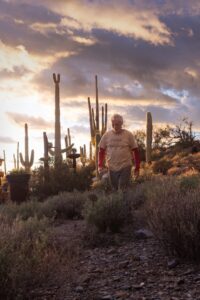


Help on the Rocks
As we speak, Dief’s phone is receiving multiple alerts. He’s always “on call” as a volunteer for animal and human rescues. In the past, there weren’t such robust public search and rescue teams, so after taking a rock climbing class in 1975, he put his skills to use with the all-volunteer Arizona Mountaineering Club Rescue Team, receiving a national certification.
He was an operations leader for the organization and was often called for night searches on the steep, rocky slopes of Camelback Mountain, once carrying down an injured rock climber with a broken femur. The group dissolved in the 1980s as the city of Phoenix developed its own personnel.
He’s still putting that knowledge to work with the Arizona Foothills 911 organization, recruiting and training local volunteers. He was part of the team of 60 volunteers who found lost hiker Kathleen Patterson after a three-day search at the Spur Cross Ranch Conservation Area in September 2022. The experience cemented his determination to lead training sessions.
Dief explains that, while sheriffs have their own search teams, the vast land area is tough to cover with just a couple dozen officers. The first day is a “hasty search” in which all trails and easy spots are checked. On subsequent days, searchers set out to examine washes, mines, caves and ridges — anywhere to which someone could have wandered.
In previous cases, helicopters were within a couple hundred feet of lost hikers’ bodies but because the human eye detects movement, it is difficult to spot a non-moving target. Searchers on the ground, combing trail by trail and acre by acre, are often the key that picks the lock of finding missing persons.
“Our strength is that we know the area,” Dief says. “We are in the process of formalizing training and utilizing Spur Cross Conservation Area to [conduct practice searches].”
Wherever he sets his sights, Dief simply doesn’t let obstacles get in his way.
A plaque hangs in one corner of the Desert Forge Studio and it’s Dief’s personal motto. It reads, “1440” — which is the number of minutes in a day — and “Do what you can do. It’s amazing what you can do if you don’t know you can’t do it.”
Building a house, forging a huge metalwork project or piece of art, rescuing humans or animals or regenerating the desert, Dief has decided to be unstoppable in the things that matter to him.
“That’s how you build mountains,” he says. “One rock at a time.”

